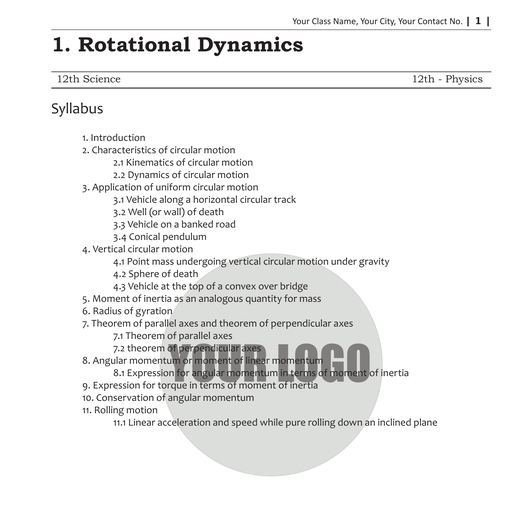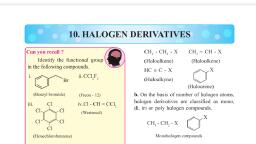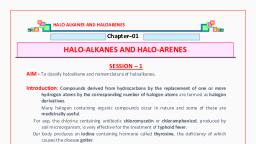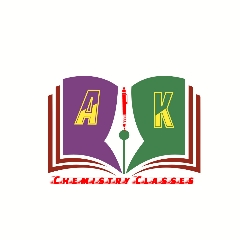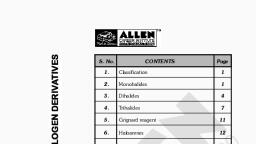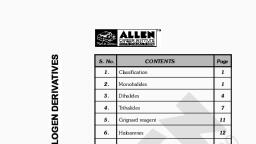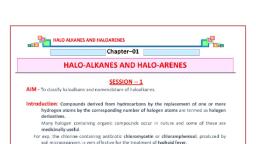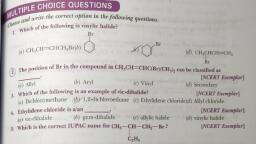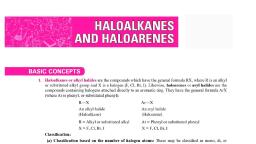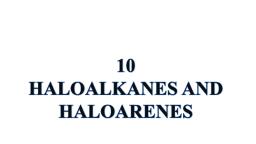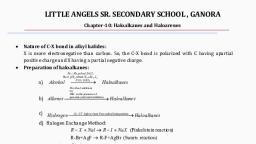Page 1 :
HALOALKANES AND, HALOARENES, , THEORY, NCERT SOLUTIONS, NCERT EXEMPLAR, WORK, SHEETS, FIND ALL YOUR QUESTIONS HERE, BEFORE GETTING THEM, IN YOUR EXAM ……...
Page 2 :
HALOALKANES AND HALOARENES (FULLY SOLVED) FOR CBSE (IIT-JEE) EXAMS (2021 - 2022), , HALOALKANES AND, HALOARENES, Introduction:, Compounds derived from hydrocarbons by the replacement of one or more hydrogen atoms, by the corresponding number of halogen atoms are termed as halogen derivatives., They are the compounds which have the general formula ‘RX’ , where, ‘R’ is an alkyl or substituted alkyl group & ‘X’ is the halogen (F, Cl, Br, I). Likewise, haloarenes, or aryl halides are the compounds containing halogen attached directly to an aromatic ring., They have the general formula ‘ArX’ (where ‘Ar’ is phenyl or substituted phenyl)., R–X, Ar – X, An alkyl halide, An aryl halide, (Haloalkane), (Haloarene), R = Alkyl or substituted alkyl, Ar = Phenyl or substituted phenyl, X = F, Cl, Br, I, X = F, Cl, Br, I, Halogen containing organic compounds occur in nature & some of these are medicinally useful., For exp, the chlorine containing antibiotic chloromycetin or chloramphenicol, produced by soil, microorganism, is very effective for the treatment of typhoid fever., , Our body produces an iodine containing hormone called thyroxine, the deficiency of which, causes the disease goiter., , Some synthetic halogen containing compounds are very useful in health–care and medicine., For example, chloroquine is used for the treatment of malaria fever., , ACTIVE SITE EDUTECH , , CONTACT: Page 1 of 38
Page 5 :
HALOALKANES AND HALOARENES (FULLY SOLVED) FOR CBSE (IIT-JEE) EXAMS (2021 - 2022), , B) Aromatic Halogen Compounds- These are obtained by replacement of one or more, hydrogen atoms of an aromatic hydrocarbon by an equal number of halogen atoms., These have been further classified into the following two major categories:, (i) Nuclear halogen derivatives (aryl halides). Halogen derivatives of aromatic hydrocarbons, in which the halogen atom (F, Cl, Br or I) is directly attached to an aromatic ring are, called aryl halides. Their general formula is Ar–X where Ar (short name for aryl), represents a phenyl, a substituted phenyl or any other aryl group such as naphthyl, etc., Some examples of aryl halides are:, , (ii) Side chain halogen derivatives (aralkyl halide). Halogen derivatives of aromatic, hydrocarbons in which the halogen atom is linked to one of the carbon atoms of the, side chain carrying the aryl group are called aralkyl halides. For example,, CH2 CH 2 Br, , Cl, , chlorobenzene, , (2-bromoethyl)benzene, , Classification based on hybridization of the carbon atom linked to the halogen:, , (A) A compound containing C–X bond, where carbon is sp3-hybridized., i) Alkylhalides or Haloalkanes: In alkyl halides, the halogen atom is bonded to an alkyl group., The homologous series is represented by CH2n+1X., They are further classified as primary (1°), secondary (2°) tertiary (3°) halides depending, upon whether the halogen atom is attached to a primary, secondary and tertiary carbon atom., Examples:, , H, R –C–X, , R2, R –C–X, , R2, R –C–X, , H, , H, , R3, , (Primary haloalkane), , (Secondary haloalkane), , 1, , 1, , ACTIVE SITE EDUTECH , , 1, , (Tertiary haloalkane), , CONTACT: Page 4 of 38
Page 11 :
HALOALKANES AND HALOARENES (FULLY SOLVED) FOR CBSE (IIT-JEE) EXAMS (2021 - 2022), , a. Initiation, , b. Propagation: During the first step, a Br adds to the double bond in such a way to give the, more stable free radical. In the second step, the free radical thus produced abstracts a, H from HBr to complete the addition., , c. Termination: It involves the following three steps:, , Exceptional behaviour of HBr: Peroxide effect is effective only in the case of HBr,, because HF and HCl are held by strong electrostatic force hence they cannot be broken, into free radicals., H–I also give corresponding halogen free radicals. I° free radical being larger in size is less, reactive towards C= C bond but readily combines with another I° to give I2 molecule., (3) From Alcohols:, Alkyl halides are prepared from alcohols by replacing –OH group of alcohols by a halogen atom., R–OH + H–X ⎯→ R–X + H2O, The replacement of –OH group can be done with HX, phosphorus halides and SOCl2., a. By action of halogen acids (Groves process), This reaction is carried out in presence of a dehydrating agent as ZnCl2 or conc. H2SO4., The 1:1 ratio of of HCl and anhydrous ZnCl2 is known as Lucas’s reagent., , ACTIVE SITE EDUTECH , , CONTACT: Page 10 of 38
Page 14 :
HALOALKANES AND HALOARENES (FULLY SOLVED) FOR CBSE (IIT-JEE) EXAMS (2021 - 2022), , 8. Stability of C–X bond decreases as the strength of C–X bond decreases. Bond strength, of C–X bond decreases as the size of halogen atom increases., ∴ bond strength of C–X bond is in the order: CH3–F > CH3–Cl > CH3–Br > CH3–I, 9. Dipole moment of RXs decreases as E.N. of halogen atom decreases from Cl to Br to I., fluorides have lower ′𝜇′than chlorides due to very small size of F which out weights the, effect of greater E.N. The actual order is: CH3Cl > CH3F > CH3Br > CH3I, , Chemical Properties:, Nature of C–X Bond, The high reactivity of RXs can be explained in terms of the nature of C–X bond which is highly, polarized covalent bond due to large difference in E.N of C and halogen atoms., , -, , or, , −𝐶 𝛿+ − 𝑋 𝛿−, , This polarity gives rise to 2 types of reactions namely nucleophilic substitution reactions and, elimination reactions., , Such reactions in which a stronger nucleophile displaces a weaker nucleophile are called, nucleophilic substitution reactions and the atom or group (halide ion in the present case) which, departs with its bonding pair of electrons is called the leaving group. Better the leaving group,, more facile is the nucleophilic substitution reaction., Mechanism of nucleophilic substation reactions:, 2 types of nucleophilic substitution reaction namely sN2 and sN1 ., 1] Substitution nucleophilic bimolecular reactions 𝐬𝐍 𝟐, If the rate of the reaction depends on the concentration of alkyl halide as well as, nucleophile, then the reaction is known as 𝑠N2 reaction., , Rate ∝ [alkyl halide] [nucleophile], sN2 Reactions are occurred in one step. During the reaction the nu attacks from the back, side (opposite side) of the halogen atom, the carbon-halogen band starts breaking and a, new carbon–nu bond starts forming. These two processes take place simultaneously in a single, step and a transition state is formed., In the transition state, the carbon atom is simultaneously bonded to the incoming, nucleophile and the outgoing leaving group. This is unstable state, it ultimately decomposes, to form the product (CH3OH) and the leaving group (Cl– ion)., , ACTIVE SITE EDUTECH , , CONTACT: Page 13 of 38
Page 17 :
HALOALKANES AND HALOARENES (FULLY SOLVED) FOR CBSE (IIT-JEE) EXAMS (2021 - 2022), , COMPARISON OF SN1 AND SN2, (a) Number of steps, , SN1, 2 steps :, , SN2, 1 step :, R : L + : Nu− → R:Nu + :L−, Or, R : L + :NuH → R : N+uH +:L−, , (i) R : L ⎯⎯⎯→ R+ + :L−, slow, , ⎯→ R:Nu + H+, (ii) R+ + :NuH ⎯⎯, fast, , (b) Reaction rate & order, , Rate = k1[RL]; first order, , (c) Molecularity, (d) TS of slow step, , Unimolecular, , Rate = k1[RL] [:Nu−]; second order, Bimolecular, , +, , −, , −, , R …… L ……HNu:, , (e) Stereochemistry, , Inversion and retention (Partial racemization), , (f) Reacting nucleophile, , Nucleophilic solvent; stable R+ may react with added, nucleophile, 3° > 2° > 1° > Me, Weakest base is best leaving group, i.e., I− > Br− > Cl− > F−, For HNu: (solvent),, rate basicity of HNu:, , (g) Structure of R, (h) Nature of Leaving group, (i) Nature of nucleophile, , (j) Solvent effect, , Rate H−bonding ability and dielectric constant, , (k) Determining factor, (l) Rearrangement, (m) Catalysis, , Stability of R+, Observed, Lewis and Bronsted acids:, Ag+, AlCl3 , ZnCl2 etc., , ACTIVE SITE EDUTECH , , Nu……C…… L− (with : Nu−), HNu……C…. L− (with : HNu), Inversion of configuration (backside, attack), Added nucleophile, +, , Me > 1° > 2° > 3°, Weakest base is best leaving group,, i.e. I− > Br− > Cl− > F−, In protic solvents,, (i) Within a periodic table group, rate, polarizability of Nu, (ii) For same nucleophilic site, rate , basicity of Nu, In polar aprotic solvents, rate, basicity of Nu, Depends on charge type. Polar aprotic, solvents leave “freest” most reactive, Nu., Steric hindrance, Not observed, except for allylic, No specific catalyst, , CONTACT: Page 16 of 38
Page 19 :
HALOALKANES AND HALOARENES (FULLY SOLVED) FOR CBSE (IIT-JEE) EXAMS (2021 - 2022), , Explanation: The formation of cyanides or isocyanides from alkyl halides involves nucleophilic, substitution reaction., • Alkali metal cyanides (KCN or NaCN) are predominantly ionic. Therefore, both carbon and, nitrogen atoms are free to donate electron pair. Since C–C bond is relatively stronger than, C–N bond, therefore, in this case attack mostly occurs through the carbon atom of the, cyanide group and alkyl cyanides are the major product., • Silver cyanide is predominantly covalent. Consequently, only nitrogen electron pair is available, for bond formation, and the attack mostly occurs through the nitrogen atom of cyanide group, giving alkyl isocyanides as the major product., 6] Substitution by nitrite group:, Alkyl halides react with aq, ethanolic solution of 𝐾𝑁𝑂2,alkyl nitrite major product formed along, with a small amount of nitro alkane., alochol, RX + K + O− − N = 0→, R − O − N = O + KX, Δ, , alochol, Ex: C2 H5 Cl + K + O− − N = O→, C2 H5 − O − N = O + KCl, Δ, , 7] Substitution by nitro group:, Haloalkanes react with aqueous ethanolic solution of AgNO2 gives nitro alkane as the major, product with a small amount of alkyl nitrite, , alochol, Ex: C2 H5 Br + AgNO2 →, C2 H5 − NO2 + AgBr, Δ, , Explanation: Nitrite ion (–O–N=O) like cyanide ion is an ambident nucleophile since it has two, sites (oxygen and nitrogen) through which it can attack an alkyl halide. Whereas attack through, nitrogen gives nitro compounds, attack through oxygen gives nitrites., , Alkali metals nitrites are ionic compounds and hence have a negative charge on one of the, oxygen atoms. Hence, it gives alkyl nitrites., In contrast, silver nitrite is a covalent compound and hence does not have a negative charge, on the oxygen atom, therefore, lone pair of electrons on the nitrogen atom is more easily, available for bond formation or nucleophilic attack occurs through nitrogen and hence silver, nitrite predominantly gives nitro compounds, , ACTIVE SITE EDUTECH , , CONTACT: Page 18 of 38
Page 21 :
HALOALKANES AND HALOARENES (FULLY SOLVED) FOR CBSE (IIT-JEE) EXAMS (2021 - 2022), , Orientation of dehydrohalogenation: If the halogen is present on the terminal C atom of, chain, dehydrohalogenation can occur only in one direction to give only the terminal alkene., For example,1-chlorobutane on dehydrohalogenation gives but-1-ene, , In the dehydrohalogenation of secondary and tertiary haloalkenes, when there is a possibility, of formation of two isomers, the hydrogen atoms is preferentially eliminated from the, adjacent carbon atom with lesser number of hydrogen atoms. This generalization is known as, Saytzeff’s rule, i.e., the more substituted alkene is more stable. For example,, , ACTIVE SITE EDUTECH , , CONTACT: Page 20 of 38
Page 25 :
HALOALKANES AND HALOARENES (FULLY SOLVED) FOR CBSE (IIT-JEE) EXAMS (2021 - 2022), , Phosgene is extremely poisonous gas. To use chloroform as an anesthetic agent, it is necessary, to prevent the above reaction. The following precautions are taken when chloroform is stored., (a) It is stored in dark blue- or brown-colored bottles which are filled up to the brim., (b) 1% ethyl alcohol is added. This retards the oxidation and converts the phosgene formed, into harmless ethyl carbonate., , Carbylamine reaction (isocyanide test): This reaction is actually a test of primary amines., Chloroform, when heated with primary amine in presence of alcoholic potassium hydroxide, forms a derivative called isocyanide (carbylamines) which has a very offensive smell., , This reaction is also used for the test of chloroform., Uses:, (i) It is used as a solvent for fats, waxes, rubber, resins, iodine, etc., (ii) It is used for the preparation of chloretone (a drug) and chloropicrin (insecticide)., (iii) It is used in laboratory for the test of primary amines, iodides and bromides., (iv) It can be used as anaesthtic but due to harmful effects it is not used these days for this, purpose. It causes liver damage when inhaled in excess (SO is CCl4)., (v) It may be used to prevent putrefaction of organic materials, i.e., in the preservation of, anatomical species., Test of chloroform:, (i) It gives isocyanide test (carbylamines test)., (ii) It forms silver mirror with Tollen’s reagent., (iii) Pure chloroform does not give white precipitate with silver nitrate., Iodoform: Iodoform resembles chloroform in the methods of preparation and properties., Iodoform reaction: Organic compounds having methyl ketone (CH3 – C O ), Or gives methyl ketone group on oxidation, when heated with I2 in presence of alkali gives, iodoform., Basic requirement for a compound to give iodoform reaction is presence of, (or), halogens to give, , ., , Group. Compounds having, , group. undergo oxidation with, , group, , ACTIVE SITE EDUTECH , , CONTACT: Page 24 of 38
Page 26 :
HALOALKANES AND HALOARENES (FULLY SOLVED) FOR CBSE (IIT-JEE) EXAMS (2021 - 2022), , p - p - Dichloro diphenyl tri chloro ethane (DDT), It is manufactured by condensation of chloro benzene with trichloro acetaldehyde (chloral) in, the presence of sulphuric acid., Cl, Cl, Cl, , Cl (Structure of DDT), , 1, , 2, , Cl, , H, , Preparation of DDT:, Cl, Cl – C – CH, Cl, , H, , Cl, , O +, , Cl, H+, , H, , Cl, , Cl – C – CH, , Cl, , Cl, , Cl, DDT, , Properties It is a white powder insoluble in water but soluble in oils., Uses It is a powerful insecticide. However, it is highly stable & is not easily decomposed in the, environment. Therefore, its long-term effect could be potentially dangerous & its use, is banned in many countries, FREONS These are poly chlorofluoro derivative of alkane., Preparation of freons :, ⎯⎯→ CCl3F + HCl, CCl4 + HF ⎯SbCl, 5, , ⎯⎯→ C2F2Cl4 + 2HCl, C2Cl6 + 2HF ⎯SbCl, 5, , hexachloro ethane, , freons–112, , Properties & uses of freons :, (a) Freons are colourless, odourless, unreactive & non-combustible liquids., (b) Having very low boiling points (e.g CF2Cl2= – 29.8ºC). They easily converted from gaseous, state to liquid state, therefore they are used as a coolant in A.C. & Refrigerator., (c) Used as a aerosol propellant in aeroplane & rockets., (d) Also used as a solvent., Note: Main cause of Ozone layer decay (CFC – chlorofluoro car, Nomenclature of Freons:, • The common name of freons is F-cba, Where c = number of carbon atoms – 1, b = number of hydrogen atoms + 1, a = total number of atoms of fluorene, Example: CFCl3 : C – 1 ⇒ 1 – 1 = 0, H + 1 ⇒ 0 + 1 = 1, F = 1 ⇒ F-11, CF2Cl2 : C – 1 ⇒ 1 – 1 = 0, H + 1 ⇒ 0 + 1 = 1, F = 2 ⇒ F-12, , ACTIVE SITE EDUTECH , , CONTACT: Page 25 of 38
Page 27 :
HALOALKANES AND HALOARENES (FULLY SOLVED) FOR CBSE (IIT-JEE) EXAMS (2021 - 2022), , Haloarenes, Compounds in which halogen is directly attached to an aromatic ring are known as aryl halides, or haloarenes and are represented as Ar –X, where 𝐴𝑟 is phenyl, substituted phenyl or a group, derived from other aromatic system., General methods of preparation:, 1. By direct halogenation of aromatic hydrocarbons: This method is used for the, preparation of chloro and bromo derivatives. Halogens react with aromatic hydrocarbons in, presence of catalysts or halogen carriers such as iron, iodine or anhydrous ferric or, aluminium chloride (Lewis acid) at room temperature in absence of direct sunlight., H, + X2, , Fe or FeX3 / dark, , + I2, , HIO3 or HNO3, , + HX (X = Cl, Br), H, + HX (X = Cl, Br), Cl, , + Cl2, , AlCl3, +, , HCl, , Br, Fe or, , Br 2, CH 3, , CH 3, Cl 2, , HBr, (Bromobenzene), , FeBr 3, CH 3, Cl, , FeCl 3, dark, (o-chlorotoluene), , Cl, (p-chlorotoluene), , For further halogenation, more halogen is used,, , The function of the Lewis acid is to carry the halogens to the aromatic hydrocarbon., If toluene is used instead of benzene, a mixture of o–and p–chlorotoluenes is obtained since –, CH3 group is o, p–directing., CH 3, , CH 2Cl, Cl 2, , 338 K, Sunlight, , HCl, 1-chloro-1-phenylmethane, , (b) Side chain halogenation-Benzylic halogenation:, The most convenient method for the preparation of side chain substituted aryl halides or, aralkyl halides is by the direct halogenation of a suitable arene. For example, when Cl2 is passed, ACTIVE SITE EDUTECH , , CONTACT: Page 26 of 38
Page 29 :
HALOALKANES AND HALOARENES (FULLY SOLVED) FOR CBSE (IIT-JEE) EXAMS (2021 - 2022), , (ii) By Gattermann reaction:, Haloarenes particularly chloro-and bromoarenes can also be prepared by Gattermann reaction., It is a modification of the Sandmeyer reaction. In this reaction, a mixture of freshly, prepared copper powder in the presence of HCl or HBr is used. The yields are often around, 40%. Thus,, , •, , From silver salt or aromatic acids–Hunsdiecker reaction: Like alkyl bromides, aryl, bromides can also be prepared by refluxing the silver salt of aromatic acids with bromine, in boiling carbon tetrachloride., C6H 5COOAg, CCl4 / Xylene, X 2 ⎯⎯⎯⎯⎯, AgX, → C6H 5 X CO 2, (Cl 2 or Br 2), , Chemical properties of haloarenes:- Aryl halides are less reactive than that of alkyl halides, towards nucleophilic substitution reactions., This can be explained as follows:, (i) Resonance Effect: In haloarenes (e.g., chlorobenzene), the lone pairs of electrons on the, halogen atom are delocalized on the benzene ring as shown below:, X, , +, , +, , X, , +, , X, , X, , X, , CANONICAL FORM, , 𝛿+ X, 𝛿−, , 𝛿−, 𝛿−, , As a result, C–Cl acquires some double bond character. On the other hand, in case of alkyl, halides (say methyl chloride) carbon is attached to chlorine by a pure single bond., Consequently, C–X bond in aryl halides is little stronger than in alkyl halides, and hence cannot, be easily broken., (ii) Bond energies due to difference in hybridization:, In alkyl halides, the carbon holding halogen is 𝑠𝑝3 −hybridised. In aryl halides, carbon is, 𝑆𝑃2 −hybridized; the carbon −halogen bond is shorter and stronger, and the molecule is more, stable., ACTIVE SITE EDUTECH , , CONTACT: Page 28 of 38
Page 30 :
HALOALKANES AND HALOARENES (FULLY SOLVED) FOR CBSE (IIT-JEE) EXAMS (2021 - 2022), , (iii) Polarity (or Nature) of the carbon halogen bond: Another reason for the low reactivity, of aryl/vinyl halides over alkyl halides is their lesser polar character., , The sp2–hybrid carbon due to greater s–character is more electronegative than a sp3–hybrid, carbon. Therefore, the sp2–hybrid carbon of C–X bond in aryl halides or vinyl halides has less, tendency to release electrons to the halogen than a sp3–hybrid carbon in alkyl halides. As a, result, the C–X bond in aryl halides or vinyl halides is less polar than in alkyl halides. This is, supported by the observation that the dipole moment of chlorobenzenes just1.69D as, compared to the dipole moment of methyl chloride i.e., 1.86 D. Consequently, the halogen atom, present in aryl halides cannot be easily displaced by nucleophiles., 1] Substitution reactions: Nucleophilic substitution reactions of chlorobenzene given below, (a) Replacemet of –Cl by –OH: When chlorobenzene is heated at 350°C under high pressure, with caustic soda, phenol is formed (Dow process)., Cl, , OH, , ONa, , NaOH, , 623 K, 300 atm, , H, , Na, , (b) Replacement by methoxy group: Ether is formed when chlorobenzene is heated with, sodium methoxide at 200°C in presence of copper salts., Cl, , OR, Cu salt (catalyst), , NaOR, High pressure, 573 K, Ether, , (c) Replacement by amino group: When chlorobenzene is treated with aqueous ammonia at, 200°C under a pressure of 60 atmospheres in presence of cuprous oxide or cuprous chloride,, aniline is formed., , 2, , 2NH 3 Cu 2O, , Cl, , 475 K, , 60 atm, , 2, , NH 2 2 CuCl, , (d) Replacement by –CN group: When chlorobenzene is treated with, pyridine or DMF at 200°C, phenyl cyanide is formed., Br, , CuCN, , DMF, , 470 K, , CN, , H 2O, , cuprous cyanide in, , CuBr, , Phenyl cyanide, , ACTIVE SITE EDUTECH , , CONTACT: Page 29 of 38
Page 33 :
HALOALKANES AND HALOARENES (FULLY SOLVED) FOR CBSE (IIT-JEE) EXAMS (2021 - 2022), , BASIC STEREOCHEMICAL PRINCIPLES AND NOTATION, OPTICAL ISOMERISM Certain organic compounds, when their solutions are placed in the, path of a plane polarized lights have the remarkable property of rotating its plane through a, certain angle which may be either to the left or to the right. This property of a substance of, rotating the plane polarized light is called optical activity and the substance passing it is said, to be optically active., , CONDITIONS FOR OPTICAL ACTIVITY:, Asymmetric or Chiral carbon atom: A carbon atom is described as being asymmetric when four, different atoms or groups are bonded to it thus an asymmetric carbon in formulas is usually indicated, by on asterik (*) placed near it., All organic compounds containing an asymmetric carbon atom are optically active., CH3, |, CH3–CH2–C*–CH2OH, |, H, , OH, |, CH3–C*–COOH, |, H, , lactic acid, amyl alcohol, (optically active), (optically active), Asymmetric or Dissymmetric molecules: Molecules which have asymmetric or dissymmetric molecular, structure in tetrahedral perspective, are called asymmetric molecules. The two features of such, structures are (i) No plane of symmetry : A 'Plane' of symmetry' is a plane which divides an object in such a way, that the part of it on one side of the plane is the mirror image of that on the other side for eg. a ball, is symmetrical while a hand is asymmetric, , Plane of symmetry, (absent), , Plane of symmetry, (present), , Similarly, an organic molecule is asymmetric if there is no plane (or centre) of symmetry for example., C, , COOH, H, , OH, OH, , H, , COOH, , C, H, , H, Br, , F, , H, Br, , ACTIVE SITE EDUTECH , , OH, H, , HO, , COOH, Symmetric, , H, , COOH, symmetic, , asymmetic, , asymmetric, , CONTACT: Page 32 of 38
Page 34 :
HALOALKANES AND HALOARENES (FULLY SOLVED) FOR CBSE (IIT-JEE) EXAMS (2021 - 2022), (ii) Non superimposable on its mirror image:, An asymmetric object cannot be superimposed on its mirror image thus right hand produces a mirror, image which is identical with your left hand. The two hands are non-superimposable which is clearing, evident if your right and in the left-handed glove. On the other hand, asymmetric object like a ball can, be superimposed its mirror image which is another similar ball., , Mirror, Cl, |, C, H, , F, Br, , Cl, |, C, , F, , H, , Mirror, COOH, COOH, |, |, C, C, OH HO, H, H, CH3, CH3, , Br, , Chirality: - This term has been recently used to describe such molecules as have no elements of, symmetry, thus symmetrical molecules are also called chiral molecules and optical activity is attributed, to certain chiral centres in them. An asymmetrical carbon is a chiral center., Chirality is lost when the two atoms bonded to an asymmetric carbon become similar thus lactic acid, is optically active but propionic acid is inactive., , Chirality or molecular dissymmetry cause of optical Isomerism, • The necessary condition for a molecule to exhibit optical isomerism is dissymmetry or chirality ., Thus, all organic compounds which contain one asymmetric carbon are chiral and exist in two, tetrahedral forms., • Although the two forms (I and II) shown in fig. (a) have the same structure, they have different, arrangements of groups a,b,d,e about the asymmetric carbon in fact, they represent asymmetric, molecules they do not have a plane of symmetry they are related to each other as an object to its, mirror image and are non-superimposable., • The two models or structures (I and II) stand for dextro or (+) and laevo or (-) isomers. Since they, are related to each other as mirror images, they are commonly called Enantiomers (Gr, enantio =, opposite, morph - form) or enantiomers thus optical isomerism is now often reflected to as an, enantiomer., , ACTIVE SITE EDUTECH , , CONTACT: Page 33 of 38
Page 35 :
HALOALKANES AND HALOARENES (FULLY SOLVED) FOR CBSE (IIT-JEE) EXAMS (2021 - 2022), •, , It is obvious that optical isomers or enantiomers due to the presence of an asymmetric carbon atom, in a compound differ only in the arrangement or configuration of groups in tetrahedral perspective, this may be illustrated by taking a few examples of compounds which exist as (+) and (-) enantiomers., , COOH, COOH Mirror, |, |, C, C, OH, H, H, HO, CH3, CH3, , Mirror, , H, |, C, C6H5, , CH3, Cl, , H, |, C, CH3, , C6H5, Cl, , (+) and (–)-1-Chloro-1-phenyl ethane, , (+) and (–)-Lactic acid, , Number of optical isomers :, Case - 1 When the molecule is unsymmetrical. (It cannot be divided into two halves), Number of d and isomers = 2n, Where n is the number of chiral carbon atoms, , Number of meso form = 0, Total number of optical isomers =, ., e.g., , 2n, , Pentane-2, 3-diol, CH3, |, H––C*––OH, |, H––C*––OH, |, C2H5, , Number of d and isomers = 22 = 4, Number of meso isomers = 0, , Case - 2 When the molecule is unsymmetrical and number of chiral carbon = even number, Number of d and isomers =2(n – 1), Number of meso isomers =2(n/2 – 1), Total number of optical isomers = 2, , (n–1), , +, , n , –1, 2 2 , , e.g. : Tartaric acid, COOH, |, H––C*––OH, |, H––C*––OH, |, COOH, , Number of d and isomers = 2(2 – 1) =21 = 2, Number of meso isomers = 2(2/2 – 1) =2º = 1, Total optical isomers = 2 + 1 = 3, , Case- 3. When the molecule is symmetrical number of chiral carbon = odd number, Number of d and isomers, , = 2(n – 1) – 2, , ( n –1), 2, , Number of meso isomers = 2, Total number of optical isomers = 2 n–1, , e.g. Pentane – 2,3,4-triole, * * *, CH3–CH–CH–CH–CH3, |, |, |, OH OH OH, , Number of d& isomers = 22 – 21 = 4 – 2 = 2, 3 –1 , , , 2 , , Number of meso isomers = 2, Total optical isomer, , ACTIVE SITE EDUTECH , , = 21 = 2, , = 23–1 = 22 = 4, , CONTACT: Page 34 of 38
Page 36 :
HALOALKANES AND HALOARENES (FULLY SOLVED) FOR CBSE (IIT-JEE) EXAMS (2021 - 2022), D, L- SYSTEM (RELATIVE CONFIGURATION) :, Optically inactive, (does not rotate plane polarised light), Organic compound, , Laevorotatory [rotates the plane polarised, (𝑙 or –), light towards left], , Optically active, (rotate plane polarised light), Dextrorotatory [rotates the plane polarised, (𝑑 or +), light towards right], , + & – isomers of an, organic compound, are optical isomers, , It is applicable for Fischer projection formula., It represents relative configuration with respect to glyceraldehydes., Following configuration of glyceraldehyde is considered as standard configuration., CHO, , CHO, , H *, , HO *, , OH, , CH2OH, , CH2OH, , D- glyceraldehyde, (– OH is on R.H.S.), , •, , H, , L- glyceraldehyde, (– OH is on L.H.S.), , All molecules which could be chemically relative to D-glyceraldehyde are assigned the Dconfiguration and those related to L-glyceraldehyde are designated L-configuration as illustrated, below COOH, H *, , COOH, HO *, , OH, , CH3, , H, , *, , H2N, , CH2OH, , (D-form), , COOH, , COOH, , (L-form), , H, , H 2N, , *, , H, , CH2OH, , CH3, , (L-form), , (D-form), , CH2OH, CHO, COOH, , CHO, H, HO, , *, *, , OH, H, , CH2OH, (L-form), , H, HO, , *, *, , NH2, H, , CH3, , C=O, , H *, HO *, , OH, H, , H *, H *, , OH, OH, , H *, H *, HO, , *, , OH, OH, H, , CH2OH, , (D-form), CH2OH, (D-form), , (L-form), , Special Point:, The method of separating a racemic mixture into its enantiomeric constituents is called as Resolution., There is no direct relation between D, L– configuration with d, l or (+), (–) configuration., ENANTIOMERS: The stereoisomers related to each other as non-superimposable mirror, , images are called enantiomers., PROPERTIES OF ENANTIOMERS :, (1) Enantiomers have chiral molecule (optically active), (2) Enantiomers have identical physical properties like BP, MP, refractive index, density etc., (3) They rotate PPL in opposite direction but to the equal extent., (4) They have identical chemical properties, However their reactivity i.e. rate of reaction will be differ, if they combine with other optically active reagent., , ACTIVE SITE EDUTECH , , CONTACT: Page 35 of 38
Page 37 :
HALOALKANES AND HALOARENES (FULLY SOLVED) FOR CBSE (IIT-JEE) EXAMS (2021 - 2022), k3, R + y ⎯⎯→, P, , k1, R + x ⎯⎯→, P, k2, S + x ⎯⎯→ P, , inactive, then K1 = K2, , k4, S + y ⎯⎯→, P, , active, then K3 K4, , (5) They have different biological properties i.e. (+) sugar play significant role in animal metabolism, while (–) sugar do not., , Meso compounds; These are the compounds containing the more than one asymmetric, carbon atom but due to the presence of plane of symmetry, do not show optical activity., They are optically inactive compounds., DIASTEROMERS: Such configurational isomers which are neither be mirror image nor be, superimpossible on each other, called as diastereoisomer., e.g., CH3, , H, HO, , CH3, H, , C=C, , CH3, , OH, H, CH3, CH3, , &, , H, , OH, OH, , H, H, , &, , CH3, H, , CH3, H, , C=C, , CH3, , (trans), , (cis), , Cis-trans isomer are geometrical isomer but they are not the mirror image thus, they are said to be, diastereomer, CHARACTERISTICS OF DIASTEREOMERS:, (1) They are generally optical active, however geometrical isomers are exception., (2) They have different physical properties like MP, BP, density, solubilities & value of specific rotation., (3) They are separated by fractional distillation, fractional crystallisation & chromatography etc., (4) They exhibit similar, , Do you want full versions of all Chemistry (Organic + Inorganic + Physical) notes?, , Contact us through the following WhatsApp Number, 9844532971, Or click below link, https://wa.me/message/NZ7T434AHPHOD1, , ACTIVE SITE EDUTECH , , CONTACT: Page 36 of 38
Page 38 :
HALOALKANES AND HALOARENES (FULLY SOLVED) FOR CBSE (IIT-JEE) EXAMS (2021 - 2022), , HOW TO, FOCUS ON, STUDIES, DURING, EXAMS, , Turn Off, The Phone, , Make a List, , Shut Off, Everything, , Find a, Comfortable, Place, , Time Yourself, ?, , Clear Your Desk, , ACTIVE SITE EDUTECH , , Award Yourself, , Frame a Picture, Of Your Goal, , CONTACT: Page 37 of 38







